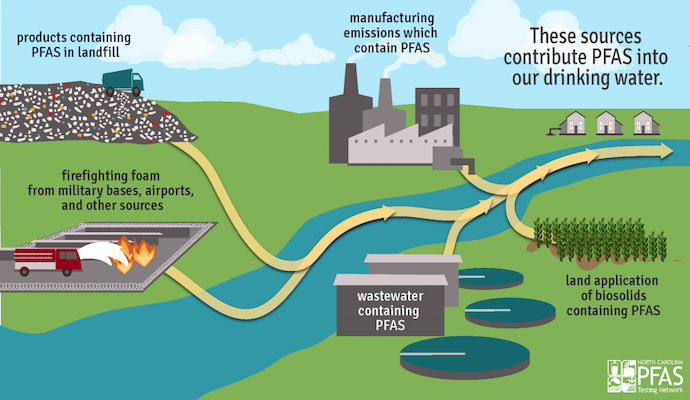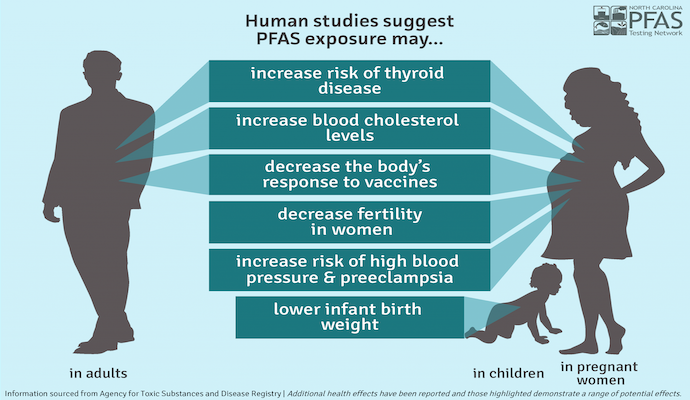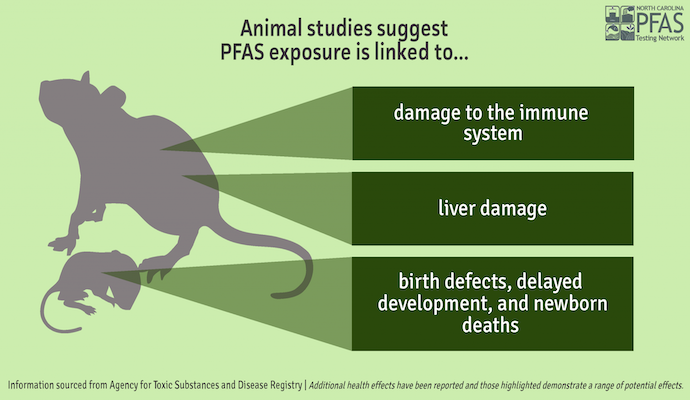
How PFAS Chemicals Globally Impact the Environment and Human Health
Per- and polyfluroralky substances (PFAS), also called forever chemicals, are a growing concern because of their widespread use and adverse human health and environmental impacts.

Forever chemicals are recognized by signature elemental bonds of fluorine and carbon, which are resistant to most biological and chemical degradation processes. These persistent, bioaccumulative pollutants have been found in humans, other animals, and the environment worldwide.
What Are Forever Chemicals?
Per- and polyfluroralky substances (PFAS) — also called “forever chemicals” — are a large chemical family of over 4,700 highly persistent human-made chemicals used since the 1940s in household and industrial settings.
Due to their ability to repel oil, grease, water, and heat, PFAS are used in numerous products such as stain-resistant carpeting, non-stick cookware, water- and grease-proof food packaging, fabric softeners, clothing, and cosmetics. They have also been used in industrial applications, including the production of electronics, aviation, and automotive parts.
After decades of widespread use, PFAS, including PFOA, PFOS, and GenX, have accumulated and persist in the ecosystem and living organisms worldwide, including humans and wildlife.
What Is Perfluorooctanoic Acid (PFOA)?
Perfluorooctanoic acid, the most well-studied PFAS, is used to make fluoropolymer coatings for products that resist heat, oil and grease, stains, and water. According to several studies, animal testing models and limited evidence suggests exposure to PFOA increases the risk of certain tumors of the liver, testicles, mammary glands, and pancreas. In 2017, the International Agency for Research on Cancer (IARC) classified PFOA as a possible carcinogen.
What Is Perfluorooctane Sulfonate (PFOS)?
Perfluorooctane sulfonate belongs to the synthetic PFAS family and has been used in some firefighting foams used at airports, firefighter training facilities, and military airfields. Although its principal US manufacturer, 3M, phased out its chemical production in the early 2000s, PFOS persists in today’s environment and may still be used in imported products.
According to an Environmental International review article, “exposure to PFOS has caused hepatotoxicity, neurotoxicity, reproductive toxicity, immunotoxicity, thyroid disruption, cardiovascular toxicity, pulmonary toxicity, and renal toxicity in laboratory animals and many in vitro human systems.”
What Is GenX?
Nearly 10 years ago, DuPont introduced GenX as a less environmentally persistent chemical substitute for PFOA. However, recent research indicates that GenX may have effects that are worse or just as harmful as PFOA.
Where Did PFAS Chemicals Originate?
In 1938, a DuPont chemist accidentally invented a waxy material called polytetrafluoroethylene (PTFE) that has been used in several household and industrial items. In his attempt to invent a better refrigerant, Roy Plunkett, PhD, discovered a substance that was later patented by DuPont and better known as Teflon — the brand name of the PTFE coating used by hundreds of non-stick cookware manufacturers around the world.
Although DuPont invented the PFAS chemical known as Teflon, 3M became its largest manufacturer. After becoming commonly used in applications in the 1950s, PFAS are now part of numerous industrial processes and consumer products worldwide.
Today, Teflon can be found in windshield wipers, stain-repellent carpets and fabrics, furniture, water-resistant clothing, lightbulbs, glass coatings, personal and hair care products, food wrappers, grease-resistant paper, microwave popcorn bags, and cleaning products, among others.
What Are the Health Risks of PFAS?
Because PFAS are highly persistent in the environment and do not break down easily, PFAS have become widespread contaminants, including in drinking water sources. The health risks and impacts of PFAS exposure and bioaccumulation are a growing concern.

According to the North Carolina PFAS Testing Network, human and animals studies have linked exposure to PFAS to a range of health effects, including increased cholesterol levels, reduced fertility, weakened immune system, increased risk of certain types of cancer, including kidney and testicular cancer, and developmental outcomes in infants and children, such as low birth weight and developmental delays.

How Are PFAS Removed?
Removing PFAS from contaminated soil, water, and air is difficult. However, several methods have been proven effective at removing these synthetic chemicals from water and soil, including activated carbon, ion exchange, reverse osmosis, and bioremediation.
In a 2022 study, researchers found that PFAS can be destroyed using lye (sodium hydroxide), commonly used to make soap, and dimethyl sulfoxide (DMSO), a liquid medication approved to treat interstitial cystitis/bladder pain syndrome (IC/BPS).
Overall, because removing PFAS from the environment can be a challenging and expensive operation, preventing their release in the first place is the best way to protect human health and the ecosystem.
PFAS Regulations
Due to the potential health risks associated with PFAS, efforts are underway to reduce or phase out their use and to remediate contaminated sites. Some federal and state organizations, including the EPA and the FDA, have also set limits on the amount of PFAS that can be present in drinking water and food products.
In November, 2016, the FDA phased out the use of long-chain PFAS, including PFOA and PFOS. As a replacement, companies have turned to the use of short-chain PFAS chemicals, such as perfluorobutane sulfonic acid and perfluorohexane sulfonic acid, which can still lead to liver and kidney damage after repeated exposure.
In 2019, the EPA issued a PFAS Action Plan outlining the agency’s approach to addressing PFAS contamination. The plan includes the following five goals.
- Develop a maximum contaminant level (MCL) for PFAS in drinking water: The EPA has proposed an MCL of 70 parts per trillion (ppt) for two of the most well-known and studied PFAS chemicals, PFOA and PFOS, in drinking water.
- Expand monitoring and testing of PFAS: The EPA is working with states to increase monitoring and testing of PFAS in drinking water and other environmental media.
- Limit PFAS releases: The EPA is taking steps to limit the release of PFAS into the environment, including by developing effluent limitations guidelines for certain industries.
- Clean up PFAS-contaminated sites: The EPA uses its Superfund program to clean up PFAS-contaminated areas nationwide.
- Promote research on PFAS: The EPA is funding research on the health effects of PFAS and developing new methods for detecting and removing these chemicals from the environment.
The EPA is also dedicated to establishing timelines by which to take specific actions and commits to bolder new policies to safeguard public health, protect the environment, and hold polluters accountable.
On December 20, 2022, 3M announced that it will abandon PFAS manufacturing and work to discontinue the use of PFAS across its entire product portfolio by the end of 2025. As more organizations continue to build upon these actions, more protective solutions like these will limit exposure and defend the health of humans, other living organisms, and the environment.






